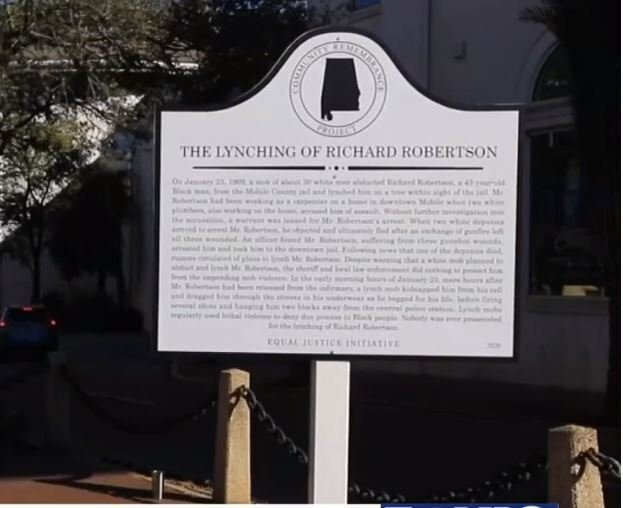Mobile, community group squabble over where to locate lynching marker

A Mobile
By BRENDAN KIRBY
Click here for updates on this story
MOBILE, Alabama (WALA) — The fate of a historic marker highlighting a 1909 lynching remains up in the air Wednesday.
The 50 member Mobile County Community Remembrance Project got a permit of the city’s right-of-way committee in April to put the marker above the Bankhead Tunnel on Government Street – in the same spot where the Confederate Adm. Raphael Semmes statue once stood.
But the city later objected and suggested an alternate location closer to where the lynching occurred.
“We followed the rules to do this,” said Mobile County Commissioner Merceria Ludgood, who headed up the group. “There was no hide-the-ball. We sent it to the city right of way committee. And that’s all we knew to do.”
City Attorney Ricardo Woods maintains that the city administration supports the Remembrance Project but suggested the intersection of Church and St. Emanuel streets would be more appropriate since that is closer to where the lynching occurred. He acknowledged that the organization went through the standard permitting process.
“However, it is unprecedented for the city to be asked to place a historic marker in a location other than where the corresponding historic event occurred,” he said in a statement. “Because of that, our process does not account for these kinds of unique circumstances.”
But Ludgood said the actual location of the lynching likely was where Interstate 10 now is. She said the Montgomery-based Equal Justice Initiative paid the $3,000 cost of the lynching marker on the basis of an application certifying that the city has approved its location.
“Had the right-of-way committee said to us in the first instance, ‘We reject this for these reasons,’ we would have gone to another option,” she said. “But that didn’t happen. And so, we just say, ‘City, you said to us this was OK. And we just want you to honor that.’”
The marker was planned as the first of six lynchings the Remembrance Project plans to commemorate in Mobile County.
According to the Remembrance Project committee, historical research shows that a 43-year-old black man named Richard Robertson was working as a carpenter on a house when two white plumbers accused him as an assault. Robertson fled when law enforcement officers showed up to arrest him, and a shootout left him and the two officers wounded.
A rumor that one of the law enforcement officers had died reportedly sparked an angry mob of 30 white men, who pulled Robertson from his jail cell on Jan. 23, 1909, dragged him through the streets in his underwear and then hanged him for a tree.
Even at the time, the lynching sparked outrage in some quarters. “Lynching Condemned At Citizens’ Meeting,” read a Mobile Register headline two days later. The article reported that a community meeting culminated in a resolution demanding the governor investigate whether the sheriff had shirked his duty by failing to prevent the mob from entering the jail.
“A call was then made for the subscription to the fund for employing attorneys and getting evidence and assisting the legal authorities of the county and state in prosecuting the person who were engaged in the lynching,” the article states.
According to the Remembrance Project, no one ever faced criminal prosecution.
On Sunday, the Remembrance Project held a ceremony at the corner of Royal and Government streets. The Semmes statue stat there for decades, before Stimpson removed it in 2020 and, eventually, had it relocated to the History Museum of Mobile.
At the ceremony, members of the committee spoke about Roberts and showed off a particleboard copy of the permanent marker, which currently sits in city storage.
“Though no longer at this site, the specter of Admiral Semmes continues to cast its dark shadow over our city,” Ludgood said.
Ludgood told FOX10 News that the project is important for racial healing.
“What do we do as a community to turn that corner?” she said. “Because if you don’t deal with it, it keeps coming up. Every time you turn around, there’s some other issue that comes up. That if you trace its roots back, it’s to these unresolved, unaddressed racial issues in our community.”
Ludgood said the organization planned to meet Wednesday night to discuss what the do next. She said there is an appeals process but noted that in this case, the city board did not reject the application. She lamented that the controversy has detracted from Robertson and the other five lynching victims.
“This is an effort that is meant to be the spark for healing,” she said. “There’s nothing intentional – we aren’t trying to be divisive.”
Woods, the city attorney, expressed concern that the Semmes site would detract from the organization’s goals.
“It is our position that the proposed non-historic site is unnecessarily controversial as it does not add to and may well detract from the historic value of the marker itself,” he said in the statement. “The placement of this marker at the former site of the Admiral Raphael Semmes statue unnecessarily politicizes the issue and could overshadow the marker’s educational value. It could also redirect the focus to the location instead of the injustice Mr. Robertson suffered in our community 113 years ago.”
Please note: This content carries a strict local market embargo. If you share the same market as the contributor of this article, you may not use it on any platform.